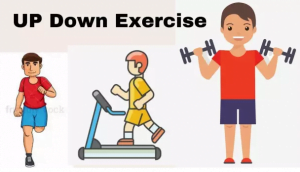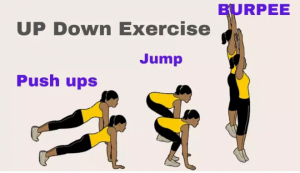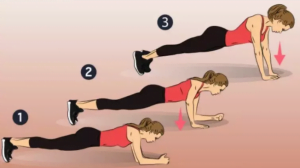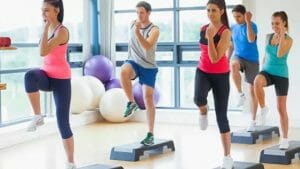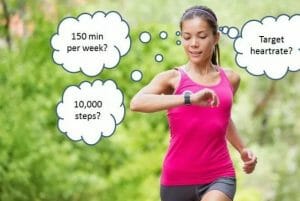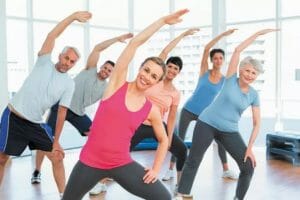Exercise is physical activity that is plan, structure and repetitive for conditioning body. The Exercise consists of cardiovascular conditioning, strength, resistance training and flexibility. In this page we Talk about UP Down Exercise| Exercise Benefits and Types.
Contents
Exercise:
Exercise is any bodily activity that enhances or maintains physical fitness. Its about overall health and wellness. It is perform for various reasons to aid growth and improve strength. This preventing aging, developing muscles and cardiovascular system, honing athletic skills, weight loss or maintenance. It improving health and also for enjoyment.
Many individuals choose to exercise outdoors. Where they can congregate in groups, socialize and enhance well being. In terms of health benefits, amount of recommended depends upon goal, type of exercise, and age of person. Even doing small amount of it is healthier than doing none. People who participate in moderate to high levels of physical exercise have a lower mortality rate compare to individuals who by comparison are not physically active.
Exercise is a training of body to improve its function and enhance its fitness. Physical is important for maintaining physical fitness. It can contribute to maintaining a healthy weight, regulating digestive system, building and maintaining. Its for healthy bone density, muscle strength and joint mobility, promoting physiological well being, reducing surgical risks and strengthening immune system. Some studies indicate that exercise may increase life expectancy and overall quality of life.
Individuals can increase fitness by increasing physical activity levels. Increases in muscle size from resistance training are primarily determine by diet and testosterone. This genetic variation in improvement from training is one of key physiological. Create Differences between elite athletes and larger population. A number of medical reviews have indicate that has a mark and persistent antidepressant effect in humans.
UP Down Exercise:
Raise one arm up and lift opposite foot up at same time. So, that your knee comes up to same height as your hips. Quickly hop from one foot to other at same time. Swing your front arm back and other arm forwards and up. As soon as you land onto other foot, repeat this process. It’s hopping and swinging your arms continuously for four strides.
After your fourth stride, crouch down and put your hands on floor underneath your shoulders. From there take your weight into your hands. Shoulders jump your feet out behind you to straighten your legs. At same time, bend your elbows and lower your upper body to floor like doing a push up. This is bottom point of movement and should be same as bottom point of your push up.
From bottom press your upper body back up away from floor. Its by pushing down with your hands. As this happens, jump your legs in underneath you, landing with your feet at shoulder width. Transfer your body weight back into your legs and stand up. As if you are doing upward part of squat.
Once standing, start running in place again for another 4 strides then do another burpee. Keep switching between running in place and a burpee every strides for require duration. Make sure you have master individual components of this exercise. That first by trying our Running in Place and Burpees exercises.
What are up downs?
Up Downs are excellent for building strength and power in legs, core, low back and upper body.
Starting position: Stand tall in an athletic stance with your feet shoulder width apart, eyes looking forward.
Movement: In one smooth, strong move, lower yourself all way to ground until you can place your hands flat on floor just outside of your feet. Try not to place your hands very far in front of your feet as this reduces intensity of workout. In similarly smooth and strong motion contract your abdominal while shifting your weight slightly onto your hands. Then explosively kick your legs back into a push-up position. The goal here is to reduce vertical movement of hips as much as possible.
Return movement: Repeat exact same steps in reverse order to return to starting position. Strongly contract abdominal and try to roll yourself into a ball while sucking your feet up and under a stable upper body. Stand up and repeat.
Variations: To make this more difficult you can add jump after returning to standing position. Kick your legs out to either side on way back or even do these on one leg. Before adding variations, make sure you can perform basic movements flawlessly. Any extraneous movements will be magnify with higher intensity. It will reduce effectiveness of exercise.
Time: Begin with 30 seconds rest between intervals.
Purpose:
Exercise is essential for improving overall health and maintaining fitness. It also helping to prevent development of obesity , hypertension and cardiovascular disease. Surveys conduct by Centers for Disease Control and Prevention. This indicate that 61.5 percent of children age nine to 13 years do not participate in any organize physical activity. And 22.6 percent are not physically active during their free time.
According to American Obesity Association approximately 30 percent of children and adolescents age six to 19 years are overweight and 15 percent are obese. A sedentary lifestyle and excess caloric consumption are primary causes of this increase in overweight and obesity.
Regular exercise is consider an important factor in controlling weight. Overweight and obese children and adolescents are higher risk of developing several medical condition. Some are including following:
- asthma
- diabetes
- hypertension
- orthopedic complications
- cardiovascular disease
- high cholesterol
- sleep apnea
- psychosocial disorders
Clinical studies have shown that regular exercise has numerous benefits. Including following:
- preventing weight gain and maintaining healthy weight
- reducing blood pressure and cholesterol
- improving coordination
- improving self-esteem and self-confidence
- decreasing the risk of developing diabetes, cardiovascular disease, and certain types of cancer
- increased life expectancy
This movement is a combination of running in place exercise. Stand on some flat ground and bend your elbows to approximately and keep that during exercise.
How to do Knee Up Down:
Some steps are given below of How to do Knee Up Down?
- Grab a pair of dumbbells and stand with feet about hip width apart.
- Step back with your left foot and drop down into a lunge so that your knee is resting on floor.
- Bring your right foot back so that you are now kneeling with both knees on floor.
- Next, raise your left knee and plant your foot in front of your. So that your knee forms 90 degree angle.
- Step up out of lung position and return to standing starting position. This completes one repetition.
Muscles Work:
Details:
Knee up down is free weights exercise that primarily targets quads. To a lesser degree also targets gluts, hamstrings and hip flexors. Learning proper knee up down form is easy with step by step. Knee up down is a exercise for those with a beginner level of physical fitness and exercise experience.
The only knee up down equipment that you really need is following: dumbbells. There are however many different knee up down variations that you can try out. That may require different types of knee up down equipment. Also it may even require no equipment at all.
Benefits of exercise:
It can reduce your risk of major illnesses. Such as heart disease, stroke, type 2 diabetes and cancer. Its lower your risk of early death. It is free and easy to take. This has an immediate effect and you don’t need a GP to get some. Its name? Exercise.
Click on links below to find out if you are doing enough for your age:
- Early childhood
- Young people
- Adults
- Older adults
Exercise is a miracle cure. We have too long we’ve neglect to take our recommend dose. Our health is now suffering as consequence. This is no snake oil. Whatever your age, there’s strong scientific evidence that being physically active. It can help you lead healthier and happier life.
People who exercise regularly have lower risk of developing many long term conditions. Such as heart disease, diabetes, stroke and cancers.
Research shows that physical activity can also boost self esteem, mood, sleep quality and energy. As well as reducing your risk of stress, depression, dementia and Alzheimer’s disease. “If exercise were a pill, it would be one of most cost effective drugs ever invent” says by a Doctor. He is a health promotion consultant.
Modern problems:
People are less active nowadays partly. Because technology has made our lives easier. We drive cars or take public transport. Machines wash our clothes. We entertain ourselves in front of TV or computer screen. Fewer people are doing manual work. Most of us have jobs that involve little physical effort. Work, household chores, shopping and other necessary activities are far less demanding than for previous generations.
We move around less and burn off less energy than people use to. Research suggests that many adults spend more hours of a day sitting down. At work, on transport and their leisure time. People age over 65 spend 10 hours or more each day sitting or lying down. Making them most sedentary age group.
Inactivity is describe by Department of Health as “silent killer”. Evidence is emerging that sedentary behavior. Such as sitting or lying down for long periods. That is very bad for your health. Not only should you try to raise your activity levels. But you should also reduce amount of time you and your family spend sitting down. Crucially, you can hit your weekly activity target. But still at risk of ill health if you spend rest of time sitting or lying down.
Common examples of sedentary behavior include watching TV, using a computer, using car for short journeys and sitting down to read, talk or listen to music. This type of behavior is thought to increase your risk of developing many chronic diseases. Such as heart disease, stroke and diabetes. As well as weight gain and obesity are also increase in our society.
“Previous generations were active more naturally through work and manual labour. But today we have to find ways of integrating activity into our daily lives”.
How much exercise do I need?
The important thing to remember about exercise is that something is always better than nothing. By simply sitting less and moving more throughout your day, you can experience health benefits. For substantial health benefits, government guidelines in U.S, UK and other countries recommend that you aim for:
At least 150 minutes (2.5 hours) of moderate-intensity activity per week:
That’s 30 minutes a day for 5 days a week, broken down into 10-minute bursts if that’s easier.
At least 75 minutes of vigorous-intensity exercise per week:
Will deliver same benefits? if your fitness level allows you to work out harder. That means running for 15 minutes. For example, instead of walking briskly for 30 minutes.
You can combine both moderate- and vigorous-intensity exercise:
Remembering general rule of thumb that 2 minutes of moderate intensity exercise. That is equivalent of 1 minute of vigorous intensity activity.
AND DON’T FORGET TO:
Include muscle strengthening activity at least twice a week as part of your weekly totals.
Looking to lose weight?
You can gain additional health benefits by exercising for 300 minutes at moderate intensity each week. This can be especially beneficial for weight loss.
Start slowly
If you have never exercise before have been sedentary for long time, it’s advisable. For start off slowly and gradually build up to these activity levels. Instead of 30 minutes of walking 5 days a week. For example, start with 5 or 10 minutes and build up from there.
How many days a week should I work out?
A recent study in UK found that people who squeeze all their exercise into one or two sessions over weekend experience. Almost as many health benefits, those who work out more often. However, spreading your exercise sessions across three or more days of week. That may help reduce your risk of injury. It keep your energy levels up throughout week.
Tips:
- You can switch which arm goes first each time if you want or do certain number of reps before switching.
- Keep your core tight the whole time and you body in a straight line.
- Remember to breathe.
- There is little point in doing this exercise fast.
- For maximum benefits do it in a steady rhythm that pays total attention to form: body straight, lower abs pull in.
I would start by incorporating 3 sets of 8 to 10 reps of up down planks at end of 2 of your normal weekly workouts or cardio sessions. A rep is complete when you return to plank position.
Conclusion:
Exercise is a training of body to improve its function and enhance its fitness. The Exercise is essential for improving overall health and maintaining fitness. Raise one arm up and lift opposite foot up at same time. So, that your knee comes up to same height as your hips. Quickly hop from one foot to other at same time. Swing your front arm back and other arm forwards and up. It’s hopping and swinging your arms continuously for four strides.
